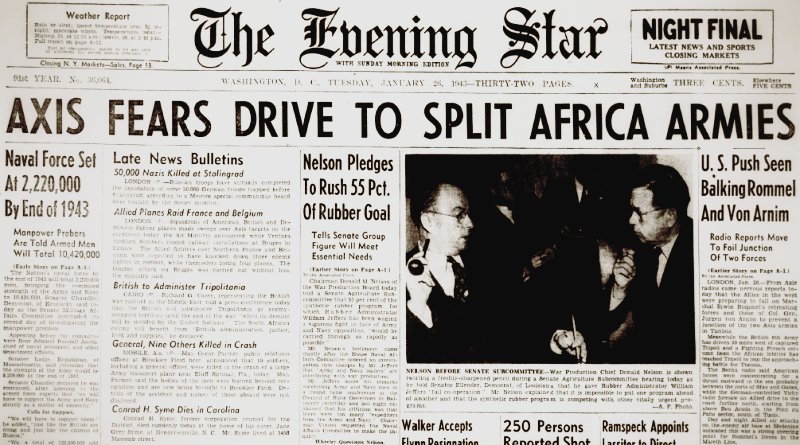World War II Chronicle: January 26, 1943
Click here for TODAY’S NEWSPAPER
Col. Robert L. Scott Jr., the commanding officer of the 23rd Fighter Group, is back in the news again (front page). His pilots have been shooting down 12 Japanese planes for every loss of their own. Scott cleverly lied his way into becoming a bomber pilot, which we discussed in a Chronicle post last month… Page six reports that Gen. Douglas MacArthur, who turned 63 today, awarded Brig. Gen. Hanford MacNider with his third Distinguished Service Cross. He received the nation’s second-highest decoration for combat valor twice during the First World War, in addition to three Silver Stars and now two Purple Hearts. MacNider served as the National Commander of the American Legion between the wars, as well as Ambassador to Canada, and campaigned to become the Republican presidential candidate in 1940. More on MacNider in this post…
George Fielding Eliot discusses the North African campaign on page eight… Former “Gas House Gang” member Pepper Martin is managing the St. Louis Cardinals’ Pacific Coast League affiliate the Sacramento Solons. But if that doesn’t work out, we learn in today’s sports page (page 13) that he has taken training to become an aircraft welder just in case. Martin will in fact return to play outfield for the Cardinals outfield next season.
Roving Reporter by Ernie Pyle
(Third and Last of a Series)
A FORWARD AIRDROME IN FRENCH NORTH AFRICA — (by wireless) — The Flying Fortress crew that made air history this month by flying 500 miles from Tripoli with its left engines out, after shooting down six enemy planes, was composed of men who were already veterans of the war in the air.
They had been decorated for missions over Europe. They already had two official kills and several probables to their credit. The Tripoli mission, which only by a miracle was not their last, was their 22nd.
The skipper of this prize crew is Lieut. John L. Cronkhite, St. Petersburg, Fla. They call him Cronk. He is short, with a faint blond mustache and a very wide mouth, from which the words come in a very slow drawl. His shoulders are broad, his arms husky. Usually he doesn’t wear a tie. He says he isn’t married because nobody would have him. He’s 23.
Cronk’s father is a St. Petersburg florist. He has three pictures of his mother and father in his room.
I spent the evening with Cronk and his co-pilot and navigator after their return from the dead. When he walked into the room Cronk picked up something from the bed.
“Hell, I can’t be dead,” he said. “Here’s my dog tag. I forgot to take it with me. I can be dead, for they wouldn’t know who I was.”
He and his co-pilot are bound by an unbreakable tie now, for together they pulled themselves away from death.
The co-pilot is Lieut. Dana F. Dudley, of Mapleton, Me. That is a little town of 800, and Dud says he is the only pilot who ever came from there. He is a tall and friendly fellow, who got married just before coming overseas. His wife is in Sarasota, Fla.
Dud says one of the German fighters dived toward his side of the plane and came on with bullets streaming until it was only 100 feet away. At that moment, what might have been his last thought passed through Dud’s head:
“Gee, I’m glad I sent my wife that $225 this morning.”
The navigator is Lieut. Davey Williams, Fort Worth, Tex. He too was recently married.
The pilots gave Davey all the credit for getting them home. He was about the busiest man on the trip, navigating with one hand and managing two machine guns with the other.
When they thought they were done for, Davey said to the pilots:
“I’ll bet those guys back home have got our stuff divided up already.”
He said he mainly thought about how he was going to get word to his family that he was a German prisoner, and he felt sore that friends of his would soon get to go home to America while he’d have to spend the rest of the war in a prison camp.
I didn’t get to talk to the other members of the crew, but their stories are just the same. They all played their parts in coax ing the broken Fortress home.
They are Lieut. Joe Dodson, bombardier, Houston, Tex., and Sergts. Carl Olson, Chicago; John King, Hartford City, Ind.; Thomas Klimaszefski, Alpena, Mich.; Robert Jackman, Cleveland; Fred Littlewold, a Chippewa Indian from Bagley, Minn., and Ted Nastel, Detroit.
One of those freakish little things happened to Lieut. Dodson. He had hung his sun glasses on a hook in the nose compartment. A machinegun bullet knocked out both lenses, but he didn’t touch the frame. If he hadn’t moved just a second before, the bullet, which grazed him, would have killed him.
When the Fortress finally reached home, Cronkhite decided to go through the co-pilot’s window onto the wing. As he stepped onto the wing his feet hit some oil and flew out from under him, and he went plummeting off the high wing onto the hard ground. The doctors thought he had been wounded, and picked him up and put him in an ambulance.
It sounds funny now, but as Cronkhite says:
“I wouldn’t have given a damn if I’d broken a leg when I fell off the wing, I was so glad to be on the ground again. I just felt like lying there forever.”
Evening star. (Washington, D.C.), 26 January 1943. Chronicling America: Historic American Newspapers. Lib. of Congress.
https://chroniclingamerica.loc.gov/lccn/sn83045462/1943-01-26/ed-1/
